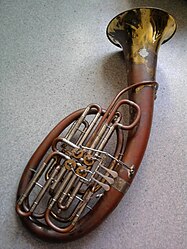Wagner tuba

Model 110 Double tuba in F/B♭ built by Gebr. Alexander Mainz. Rhein. Musikinstrumentenfabrik GmbH (Mainz, Germany).
|
|
| Brass instrument | |
|---|---|
| Other names |
en: Wagner tuba, de: Wagnertuba, it: Tuba wagneriana, fr: Tuba wagnérien |
| Classification | |
| Related instruments | |
| More articles | |
The Wagner tuba is an infrequently-used brass instrument that combines tonal elements of both the French horn and the trombone. Wagner tubas (or Wagnertuben) are also referred to as Wagner horns or Bayreuth tubas in English and as Bayreuth-Tuben or simply Tuben in German. The term Wagner tuba has been used in English since the 19th century and is standard today. Wagner's published scores usually refer to these instruments in the plural, Tuben, but sometimes in the singular, Tuba.
The Wagner tuba was originally created for Richard Wagner's operatic cycle Der Ring des Nibelungen. Since then, other composers have written for it, most notably Anton Bruckner, in whose Symphony No. 7 a quartet of them is first heard in the slow movement in memory of Wagner, and Richard Strauss, who composed several works that used the Wagner tuba, including his Alpine Symphony.
Wagner was inspired to invent the Wagner tuba after a brief visit to Paris in 1853. He visited the shop of Adolphe Sax, the inventor of the saxophone and saxhorn. They showed him a saxhorn, which is similar to the instrument that Wagner ultimately wanted, and later had constructed by the C. W. Moritz firm in Berlin. Wagner wanted an instrument that could produce the noble and sombre Valhalla motif in Das Rheingold like a trombone, but with a less incisive tone like that of a horn.
That Wagner tuba aural effect is obtained by a conical bore (like a horn) and the use of the horn mouthpiece (tapered and conical, as opposed to the parabolic cup mouthpiece such as on a trombone). The saxhorn had a more cylindrical and larger bore, used the parabolic cupped mouthpiece, and thus had a more brassy tone that wasn't quite suitable for Wagner's tonal intent.
...
Wikipedia
